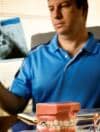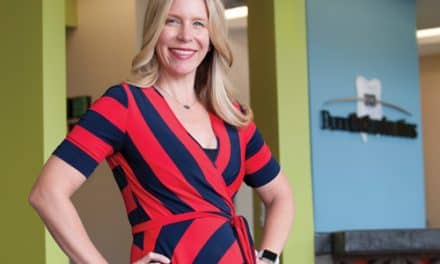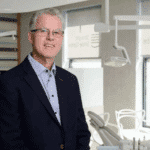by Lori Sichtermann
A “less is more” business model has helped Glenn C. Dubroc, Jr, DDS, thrive in a rebuilding New Orleans
Photography by Michael Palumbo

Most traditional orthodontic practices are bustling with activity, as multiple staff members and assistants attend to doctors, patients, and families. However, at the New Orleans office of Glenn C. Dubroc, Jr, DDS, things are done a bit differently.
“I only have one person in the office who handles the front desk, and it’s only me in the back assisting patients,” Dubroc explains. “We keep it simple because we want to focus on each patient and devote as much time to that person as possible.”
Keeping it simple has been the mantra for Dubroc since he started practicing 20 years ago. Where many practices see an average of 80 to 100 patients per day, Dubroc’s office sees an estimated 30 patients a day. The reduced patient volume means that he needs less staff, resulting in an average office overhead of 21% over the past 10 years.
Although his practice experiences its share of bustling, its overall feel is relaxed, welcoming, and focused. “Seeing a limited number of patients per day allows for the amount of time I like to spend with each patient and his or her family,” Dubroc adds. “I can focus on their unique needs, and that has translated into higher quality of results.”
As Dubroc further explains, the attention he gives to each patient actually allows him to treat them more efficiently. “Ninety-five percent of the time, we’re able to get the patient out of his or her braces in the time that we estimated that it would take to finish,” he says. “And that’s a significant factor for patients.” Dubroc adds, “Completing my Board certification 10 years ago was a rewarding and educational experience. It motivated me to become as efficient as possible at completing cases to Board standards within reasonable treatment periods.”
Dubroc enjoys the flexibility of customizing his practice’s patient load to fit his comfort level. In fact, it was the independence of being a business owner that attracted him to the profession from a young age. “My dad had always told me as a young boy that I should pursue a career that would enable me to be my own boss,” he explains. “I always thought that my dentist was a nice guy, and I enjoyed the environment he created. As a result, dentistry kind of popped from the beginning.”
More so than the ability to schedule his own hours and set the tone of the working environment, Dubroc’s attraction to the orthodontic profession is rooted in a desire to help patients and develop lasting relationships throughout the duration of care.
“Interaction with the patients is my favorite aspect of the profession,” Dubroc says. “An orthodontist sees his or her patients on a more routine basis compared to a general dentist, so we really do develop long-term relationships with our patients and their families. To me, these relationships are very valuable and meaningful.”
The complications involved with the profession also keep him motivated. “I like challenges, and one thing about being an orthodontist is every day offers a new set of difficulties,” he explains. “In 6 months I can make a patient’s mouth look completely different—I’m moving forward with the puzzle.”
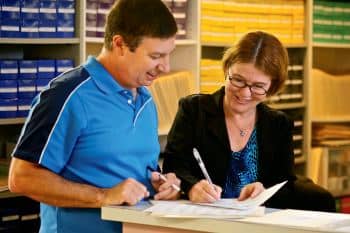
Dubroc’s wife, Bobbi, is also his practice’s office manager.
A Time of Need
In August 2005, after 14 years of practicing orthodontics, Dubroc’s habit of running a simple operation served as a salvation for the business. When Hurricane Katrina hit New Orleans, Dubroc’s orthodontic office was shut down and his client base was devastated. “The practice at the time was on the fourth floor of an office complex, so our equipment and files were relatively safe,” he explains. “However, the building where the office was located took on nine feet of water. It took 17 days before the water receded and we were able to enter the office and retrieve our files and equipment.”
In the immediate aftermath of the storm, Dubroc and his wife, Bobbi (a trained dental hygienist and the office manager of the practice), began the daunting task of locating each and every patient enrolled at the practice. “We used every aspect of information we had about the families. We used cell phone numbers, e-mail addresses, even the phone numbers of relatives we might have on file in order to locate our patients,” Dubroc explains. “This took about 3 weeks of nonstop, morning-to-night phone calls.”
The area of New Orleans from which Dubroc’s patients originated was one of the hardest hit by the storm. As a result, most of the residents in the area lost their homes and subsequently scattered to other parts of Louisiana or to other areas of the country. “The first challenge was finding everyone. And, of course, those telephone conversations were never easy,” Dubroc says. “It was always a discussion of survival and how the patient and their families were doing. It was mentally and physically exhausting to call all of those patients and to go through that over and over again.”
Although the task was stressful, Dubroc and his wife were able to locate every single patient. In the end, Dubroc realized that 50% of his client base was located elsewhere in Louisiana and the other 50% was scattered throughout 27 different states. Even with patients spread across the country, Dubroc wanted to continue care in every way possible. “I had built relationships with my patients and their families, and I wanted them to know that I cared for them, especially in light of what we’d all gone through,” he says.
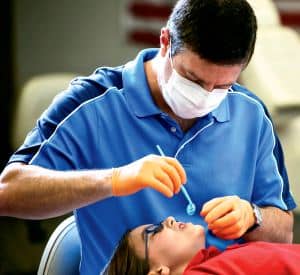
Dubroc spends as much time as he can with each patient.
For the patients who were still in Louisiana, Dubroc contacted colleagues throughout the state and asked to borrow their office on a day in which it would be closed. “I owe an enormous debt of gratitude to Drs William Sansing (Alexandria), Sean Smith (Baton Rouge), and Jack Devereux (Slidell), who opened their arms to us and basically said, ‘My office is your office.’ ” From there, Dubroc contacted his patients who had evacuated to the vicinity of those colleagues’ offices and scheduled appointments so he could continue treatment.
“We moved around the state, essentially working out of the trunk of my car,” Dubroc explains. “I brought all my files and materials with me and borrowed those orthodontists’ physical space. That’s how we kept those patients going until we could return to our own office.”
Thanks to his operational philosophy of keeping it simple, Dubroc was able to move about the state with relative ease. “It was just me and my wife on the road, moving around the state, taking care of patients,” he says. “Because it was just the two of us, we were very mobile. That was essential in order to take care of all those patients.”
For patients who settled beyond Louisiana, Dubroc helped as much as possible. “We had to arrange for them to see an orthodontist in the area where they were living until they could get back to New Orleans,” he says. “Or, if they decided not to return, we encouraged them to see a local orthodontist until they officially transferred their care to a new doctor.”
PRACTICE PROFILE
Glenn C. Dubroc, Jr, DDS
Location: New Orleans
Specialty: Orthodontics
Average patients per day: 30
Starts per year: 120
Years in private practice: 15
Days in practice per week: 3 1/2
Even with patients who found new orthodontists, Dubroc kept involved. “We encouraged our patients to find an orthodontist and then have that doctor contact me,” he explains. “Once that doctor contacted me, I duplicated and sent the records. Unfortunately, I became an expert at patient transfers.”
It has been 6 years since Hurricane Katrina made landfall in New Orleans, and Dubroc, much like the city, continues to rebuild. “We lost approximately 30% to 35% of our practice after the storm,” he notes. “These patients and their families realized it would be too costly or too stressful to come back, so they permanently relocated.”
In the time since the storm, Dubroc’s practice has been on a steady path toward growth, but elements such as the massive Deepwater Horizon oil spill in April of 2010 have altered the city’s—and Dubroc’s—trajectory of progress. “The oil spill really hurt a lot of industry on the Gulf, which was vital to the New Orleans economy,” Dubroc explains. “The effects of that spill were pretty damaging, and they couldn’t have happened at a worse time for all of us.”
Today, Dubroc operates a healthy practice, and it’s growing with every passing year. The office’s low overhead makes it able to absorb financial fluctuations. “I can’t say that my practice is what it was prior to the storm; it’s probably down 10% to 15% from what it was pre-Katrina. But, that’s OK; we’re still doing well,” Dubroc notes. “People have to realize that the population of the city has changed dramatically since the storm. We estimate that the city is 30% less populated than it was before Katrina. But, it’s growing and gradually coming back. When you look at the scope and see what the storm did to our city, you can understand that it’s going to take a while to get back to where we were.”
Teaching the Simple Way
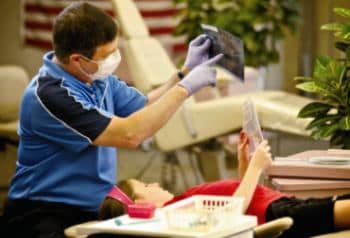
Dubroc, his practice, and the city of New Orleans all have endured a number of difficult events throughout the last several years. However, as time passes, each is gaining ground in the path toward recovery. As Dubroc works to rebuild his practice, he also is dedicated to ensuring the strength of the orthodontic profession.
For the last 16 years, he has taught orthodontics at Louisiana State University. “The interaction with the residents is the most rewarding part of it,” he says. “They keep you young and on your toes. They challenge you mentally, and it’s rewarding to give back to the profession that has given so much to me.”
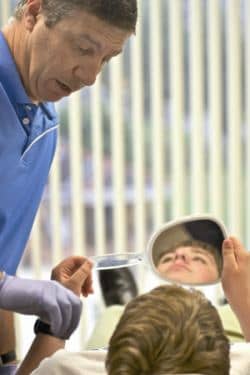
After 16 years of teaching, Dubroc recalls with pride that he’s been able to contribute to the education of more than 60 residents. In addition to teaching fundamentals and techniques of orthodontics, Dubroc also shares with students his “less is more” business philosophy. “Because my business is unique in how it operates, I want them to see that there are other ways to be a successful orthodontist,” he explains. “You don’t have to have an office with 20 assistants in order to be financially or socially successful. You can do it on a smaller scale and still be financially successful and still enjoy what you’re doing.”
One of the ways in which Dubroc demonstrates the ability to keep it simple while maintaining a successful business is his use of technology within his practice. “Because I teach, I stay abreast of everything that is new and innovative within our industry,” he explains. “And, I’ve found that in many instances, orthodontists tend to utilize technology, almost excessively so. However, it’s not a huge part of my practice.”
Dubroc’s office uses technology that’s common to most practices. X-ray equipment, modern impression materials, advanced wires, and new forms of braces are all part of the lineup. “We have x-ray equipment and computer equipment like any other office does, but we really use good, old-fashioned educational techniques rather than trying to rely on software programs that aren’t unique to each patient,” Dubroc explains. “We really take a more individualized patient approach.”
As he explains, this method has suited his business perfectly for 2 decades. “We want to keep things as simple as possible and not complicate our lives,” he explains. “When you’re seeing 100 or more patients a day, that’s a lot of people you’re responsible for, so it takes a toll on you, mentally and physically. With that said, I emphasize to my residents that there are many successful practice modalities. You have to choose the modality that best suits your personality, goals, and priorities.”
Lori Sichtermann is a contributing writer for Orthodontic Products. For more information, contact
Rebuilding His Alma Mater
Years ago, Dubroc’s father encouraged him to enter a profession that would allow him to be his own boss. Dubroc has owned and operated his own practice for more than 20 years, and the benefits of being his own boss show in how he spends his time each week. “I see patients 3½ days a week,” Dubroc says. “I teach for half a day on Wednesday, and on Friday I volunteer my time in some capacity to give back to the community. The fact that I have this kind of schedule and still make a good living is wonderful.”
Although Dubroc has volunteered with a number of organizations in the New Orleans area, the one that he’s particularly dedicated to is his high school alma mater, Holy Cross School in New Orleans. As he explains, the school and the campus were completely destroyed by Hurricane Katrina.
“My grammar school, middle school, and high school were all destroyed by Katrina,” Dubroc adds. “After the storm, each of those buildings were rendered uninhabitable. The flood waters were so high that they ravaged the buildings, and it wasn’t financially or logically feasible to go back and reopen those schools. Thus, they were demolished.”
In an effort to reopen his high school alma mater, Dubroc joined the Holy Cross Board of Directors 5 years ago and currently serves as the chairman of the board. “We are actively rebuilding a new campus and pushing the school back to where it was before the storm,” he says. “We’re making a lot of progress, but it is a lot of work.”
In the years since Dubroc joined the Board of Directors, the school has managed to open and operate in three different locations and buildings. Today, Dubroc and the Board are happy to report that the school is at last settled on its final campus. “The students are finally back in the classrooms again, and the school is growing rapidly,” Dubroc says. “We’re really excited about the progress.”
As rewarding as it has been to assist in a task as profound as rebuilding a school, there is a tinge of bittersweet nostalgia that comes along with replacing a personal landmark. “It’s sad, but you move on. It’s part of the challenge of life,” Dubroc says. “You pick yourself up and move forward. There’s really nothing else you can do.”
As Dubroc and other residents of New Orleans continue to rebuild their lives, businesses, and communities in the wake of Hurricane Katrina, partnership among citizens has played a pivotal role. “Fortunately, we were blessed to have so many friends and family who were able to give us support, and it was wonderful to see people come together and help each other,” Dubroc says. “To see the goodness in people that came out of an extreme event like that was very touching.
“We also learned that life will test you, and this was a big test for us,” he continues. “There were a lot of gut-check moments about what to do next. But we learned that if you plan appropriately, work hard, and you know what your ultimate goals are, you can survive through anything.” —LS

